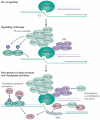DNA interstrand crosslink repair and cancer
- PMID: 21701511
- PMCID: PMC3560328
- DOI: 10.1038/nrc3088
DNA interstrand crosslink repair and cancer
Abstract
Interstrand crosslinks (ICLs) are highly toxic DNA lesions that prevent transcription and replication by inhibiting DNA strand separation. Agents that induce ICLs were one of the earliest, and are still the most widely used, forms of chemotherapeutic drug. Only recently, however, have we begun to understand how cells repair these lesions. Important insights have come from studies of individuals with Fanconi anaemia (FA), a rare genetic disorder that leads to ICL sensitivity. Understanding how the FA pathway links nucleases, helicases and other DNA-processing enzymes should lead to more targeted uses of ICL-inducing agents in cancer treatment and could provide novel insights into drug resistance.
Figures




Similar articles
-
DNA interstrand cross-link repair: understanding role of Fanconi anemia pathway and therapeutic implications.Eur J Haematol. 2013 Nov;91(5):381-93. doi: 10.1111/ejh.12169. Epub 2013 Aug 17. Eur J Haematol. 2013. PMID: 23859405 Review.
-
Fanconi anemia-independent DNA inter-strand crosslink repair in eukaryotes.Prog Biophys Mol Biol. 2020 Dec;158:33-46. doi: 10.1016/j.pbiomolbio.2020.08.005. Epub 2020 Aug 30. Prog Biophys Mol Biol. 2020. PMID: 32877700 Free PMC article. Review.
-
The FANC/BRCA Pathway Releases Replication Blockades by Eliminating DNA Interstrand Cross-Links.Genes (Basel). 2020 May 25;11(5):585. doi: 10.3390/genes11050585. Genes (Basel). 2020. PMID: 32466131 Free PMC article. Review.
-
The Fanconi anemia pathway in replication stress and DNA crosslink repair.Cell Mol Life Sci. 2012 Dec;69(23):3963-74. doi: 10.1007/s00018-012-1051-0. Epub 2012 Jun 29. Cell Mol Life Sci. 2012. PMID: 22744751 Free PMC article. Review.
-
Double-strand breaks induce homologous recombinational repair of interstrand cross-links via cooperation of MSH2, ERCC1-XPF, REV3, and the Fanconi anemia pathway.DNA Repair (Amst). 2007 Nov;6(11):1670-8. doi: 10.1016/j.dnarep.2007.06.002. Epub 2007 Jul 31. DNA Repair (Amst). 2007. PMID: 17669695 Free PMC article.
Cited by
-
The roles of DNA polymerase ζ and the Y family DNA polymerases in promoting or preventing genome instability.Mutat Res. 2013 Mar-Apr;743-744:97-110. doi: 10.1016/j.mrfmmm.2012.11.002. Epub 2012 Nov 26. Mutat Res. 2013. PMID: 23195997 Free PMC article. Review.
-
DNA interstrand cross-link repair requires replication-fork convergence.Nat Struct Mol Biol. 2015 Mar;22(3):242-7. doi: 10.1038/nsmb.2956. Epub 2015 Feb 2. Nat Struct Mol Biol. 2015. PMID: 25643322 Free PMC article.
-
Circular DNA intermediates in the generation of large human segmental duplications.BMC Genomics. 2020 Aug 26;21(1):593. doi: 10.1186/s12864-020-06998-w. BMC Genomics. 2020. PMID: 32847497 Free PMC article.
-
Aberrant DNA damage response pathways may predict the outcome of platinum chemotherapy in ovarian cancer.PLoS One. 2015 Feb 6;10(2):e0117654. doi: 10.1371/journal.pone.0117654. eCollection 2015. PLoS One. 2015. PMID: 25659114 Free PMC article. Clinical Trial.
-
Fanconi proteins get histones moving.EMBO J. 2012 Aug 29;31(17):3511-2. doi: 10.1038/emboj.2012.222. Epub 2012 Aug 7. EMBO J. 2012. PMID: 22872149 Free PMC article.
References
-
- Goodman LS, et al. Nitrogen mustard therapy. Use of methyl-bis(β-chloroethyl)amine hydrochloride and tris(β-chloroethyl)amine hydrochloride for Hodgkin’s disease, lymphosarcoma, leukemia and certain allied and miscellaneous disorders. J. Am. Med. Assoc. 1946;132:126–132. - PubMed
-
- Eastman A. Reevaluation of interaction of cis-dichloro(ethylenediamine)platinum(II) with DNA. Biochemistry. 1986;25:3912–3915. - PubMed
-
- Gargiulo D, Kumar GS, Musser SS, Tomasz M. Structural and function modification of DNA by mitomycin C. Mechanism of the DNA sequence specificity of mitomycins. Nucleic Acids Symp. Ser. 1995:169–170. - PubMed
-
- Kozekov ID, et al. DNA interchain cross-links formed by acrolein and crotonaldehyde. J. Am. Chem. Soc. 2003;125:50–61. - PubMed
Publication types
MeSH terms
Substances
Grants and funding
LinkOut - more resources
Full Text Sources
Other Literature Sources
Molecular Biology Databases

